A Visit To The Iconic Wat Arun Temple In Bangkok
Exploring The Temple Of Dawn
THAILAND
Adam Shaw
2/3/20254 min read
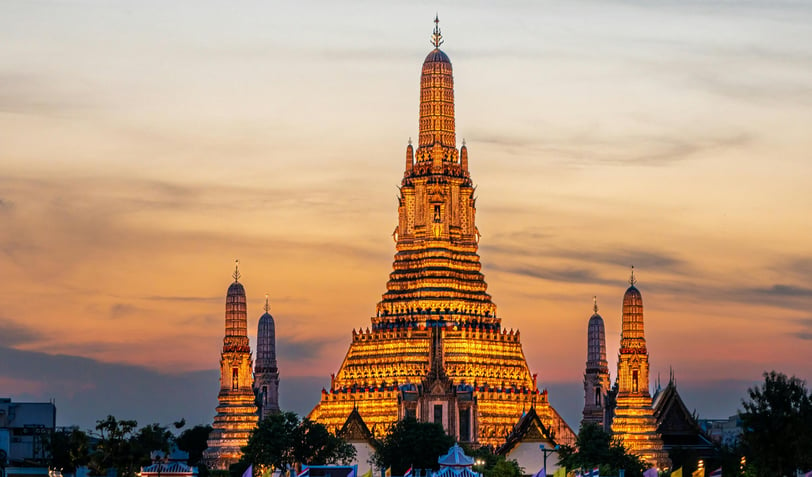

Wat Arun, which is also known as the Temple of Dawn, is one of Bangkok’s most iconic landmarks. It is an absolutely stunning Buddhist temple, that is located on the western bank of the Chao Phraya River, and has a very captivating architectural design.
Quick History Facts
Origins date back to the 17th century during the Ayutthaya period
Originally named Wat Makok after the village where it was built
When King Taksin established Thonburi as the new capital in 1767 following the fall of Ayutthaya, he renamed it Wat Chaeng
It is said that King Taksin arrived at the temple at dawn after his victory over the Burmese, which led to its modern day nickname, the Temple of Dawn.
The temple underwent major renovations during the reign of King Rama II (1809–1824) of the Chakri Dynasty.
King Rama III (1824–1851) completed the renovation, transforming Wat Arun into the grand temple it is today. He adorned the main prang with colourful porcelain and seashells.
Wat Arun’s most distinctive feature is its 80 meter tall prang, which is surrounded by four smaller satellite towers.
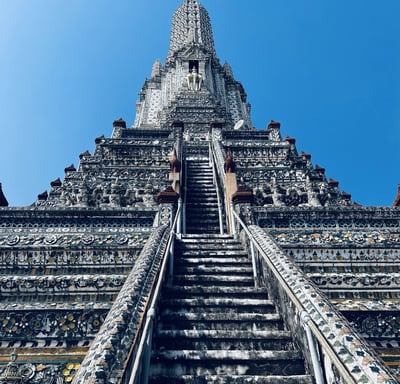

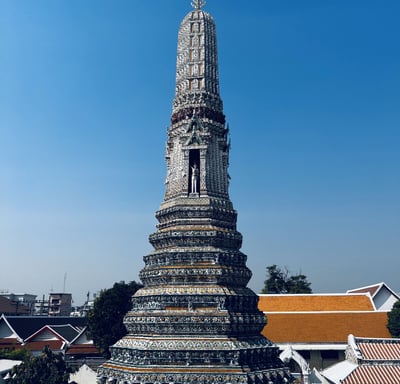

Best Time Of Day To Visit
Wat Arun is one of Bangkok’s most visited attractions, which means it can get very crowded, especially during high season (Nov-Feb). I have visited the temple on 2 occasions, once around midday and another at 9am. I would definitely recommend going between 8-10 in the morning , for a number of reasons;
Cooler Weather: Bangkok’s heat and humidity can be overwhelming by midday. Arriving before 10am allows you to explore the temple in more comfortable temperatures.
Fewer Crowds: Most tourists visit later in the day, so early hours provide a quieter, more intimate experience.
Beautiful Morning Light: The soft morning sun creates a golden glow on the temple’s spires, great for taking photos.
A Spiritual Start to the Day: Morning is a peaceful time when monks perform their rituals, which will give you a glimpse into the temple’s spiritual life.


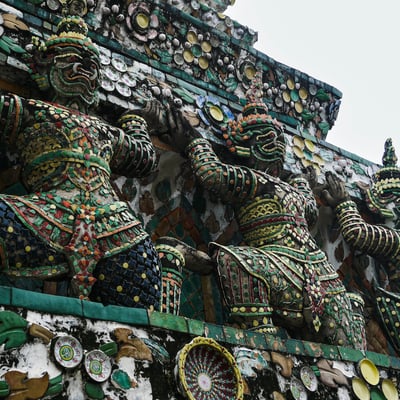

Getting There
Due to the temple being located on the western bank of the Chao Phraya River, there are a number of ways to get there;
1. By Boat (Recommended)
One of the most scenic and convenient ways to reach Wat Arun is by boat;
From Saphan Taksin BTS Station: Take the BTS Skytrain to Saphan Taksin Station and walk to the Sathorn Pier. From there, board a Chao Phraya Express Boat heading north.
Get off at Tha Tien Pier: Once you reach Tha Tien Pier (where the Grand Palace and Wat Pho are located), take the cross river ferry to Wat Arun for just 5 Thai Baht.
Enjoy the View: The boat ride provides a fantastic view of Bangkok’s skyline, and you’ll be able to see Wat Arun’s stunning silhouette on your approach.
2. By Taxi or Grab
If you prefer direct transportation, taking a taxi or Grab (Thailand’s version of Uber) is another option. Be sure to go early, as Bangkok’s traffic can be heavy, even in the morning. So would suggest leaving before rush hour (around 7–8 AM). Grab is usually my preference as the price is fixed.
3. By Tuk-Tuk
For a more adventurous and authentic Thai experience, you can take a tuk-tuk. They are a very fun way to explore the city, though in my experience they tend to be more expensive than taxis. So would always recommend negotiating the price before starting the trip.
4. By Public Bus
If you are looking for a more budget friendly option, then you can take a bus. Bus numbers 19, 57, and 83 stop near Wat Arun, but figuring out the bus routes can be challenging for first time visitors.
5. By Walking (If Staying Nearby)
If you’re staying near the riverside, in areas like Bangkok Yai or Thonburi, you might be able to walk there.
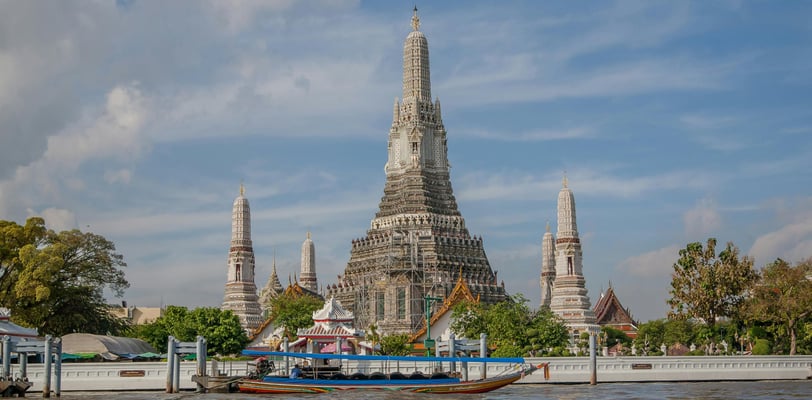

Why Visit
You'll be amazed by the architectural beauty when you arrive at Wat Arun. The central prang is covered with colourful porcelain and seashells, which create a very unique dazzling effect when hit by sunlight. The intricate patterns and statues of mythical creatures make it one of Thailand’s most unique temples.
If you are unfazed by heights, climbing the steep steps of the central prang gives fantastic views of the Chao Phraya River and Bangkok’s skyline. The climb can be challenging though, so best to wear comfortable shoes.
The main tower is surrounded by beautifully maintained temple grounds, which include smaller prangs, Buddha statues and peaceful gardens for you to have a wonder around.
Since Wat Arun is a religious site, you will need to dress modestly. So wear clothing that covers shoulders and knees, or bring a scarf/sarong, but if needed, proper attire can be rented near the entrance.
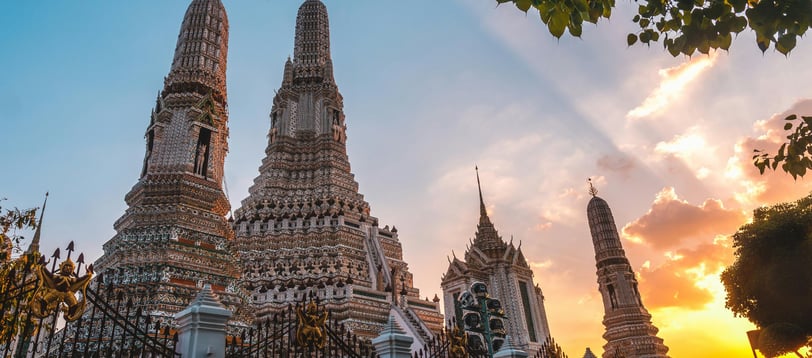

Final Thoughts
Overall, I had a great experience exploring Wat Arun, and would definitely recommend visiting before 10am when there are less crowds and the temperature is cooler. I have read other blogs that advise admission is 50 Thai baht per person, but at the time of my last visit (February 2025) admission was 200 baht per person for non-thai residents. I was truly amazed by the architecture , and is a unique experience being able to climb the steps and see all the intricate details up close. In my opinion 1-2 hours is enough time to see everything. I would also recommend visiting one of the restaurants/bars on the opposite side of the river one evening for sunset (Sala Rattanakosin or Inn A Day) to witness the temple lit up and will be able to capture some magical photos from a distance.
Get in touch
hello@abundantasiatravel.com


Affiliate Notice
This website uses affiliate links, meaning we may earn a commission if you make a purchase through a link.
